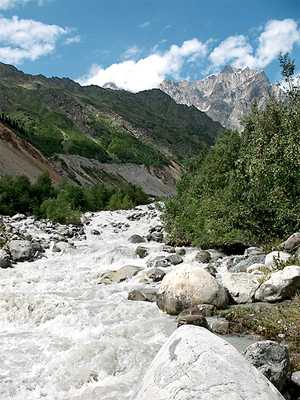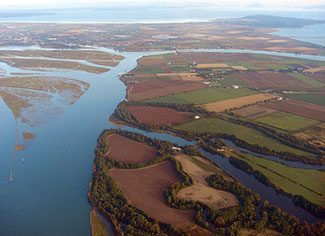
Source: Chalaati River Gorge, gobe67, flickr
Read the information below about how erosion helps to deposit sediment in other areas. Then practice what you have learned by completing the matching activity below.

Source: Chalaati River Gorge, gobe67, flickr
Erosion happens at the tops of mountains and under the soil. Water and chemicals get into the rocks and break up the rocks through mechanical and chemical forces.
Erosion in one area can actually build
up lower areas. Think about a mountain range and a river. As the mountain erodes, the river carries sediment downstream towards the ocean.

Source: Quilted, esctascist, Flickr
The sediment slowly builds up and creates new wetlands at the mouth of the river. This movement of sediment is called deposition which creates landforms such as floodplains and river deltas.
![]() Find the correct answer for each question below by clicking and
dragging each answer to the matching question.
Find the correct answer for each question below by clicking and
dragging each answer to the matching question.
Read the excerpt below, "The Mighty Mississippi" and think about why flooding was a benefit to the Mississippi region. Then view the video segment ![]() "Flood: Farming and Erosion" to learn more about the effects of farming on the processes of erosion along the Mississippi River.
"Flood: Farming and Erosion" to learn more about the effects of farming on the processes of erosion along the Mississippi River.
Answer the following questions in your notes:
The Mighty Mississippi
The Mississippi River watershed drains more than one-third of the United States; rain falling in eastern Montana may eventually end up in the Gulf of Mexico. Such an expansive watershed accommodates a huge volume of water. On average, the Mississippi carries 173,600 cubic meters of water per second. On occasion, however, this great river overflows its banks and inundates a wide swath of land on either side known as the floodplain.
Flooding is a natural part of the life of a river. Before humans intervened, the Mississippi River flooded every year. In fact, floods and the sediments they deliver are largely responsible for the richness of the soil found in floodplains. Unfortunately, these soils and other resources provided by the river have also encouraged people to build communities in the paths of floodwaters.
-Teachers' Domain, Flood: Farming and Erosion, published December 17, 2005, retrieved on July 27, 2010